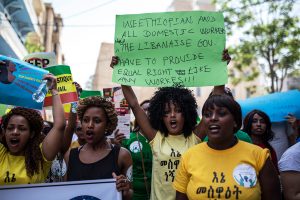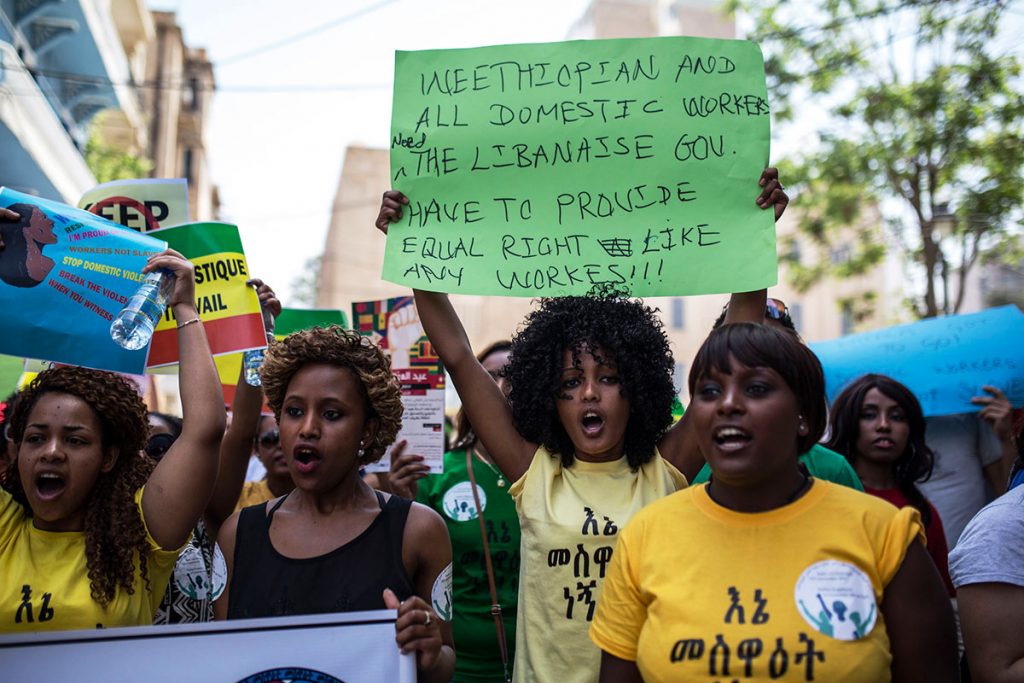
A woman with a pink cloth wrapped around her head climbs out of a window on the fourth floor of a residential building. She peers at the ground far below, clutching onto the window ledge as voices in the background yell at her to come inside. Instead, she jumps, her scream lingering for four seconds before she hits the ground.
The video was broadcast on Lebanon’s Al-Jadeed TV in March, with a voiceover explaining that the woman was an Ethiopian domestic worker in Khalde, an area south of Beirut.
According to statistics obtained by IRIN from General Security, Lebanon’s intelligence agency, migrant domestic workers in Lebanon are dying at a rate of two per week. Many of the deaths are suicides or botched escape attempts in which migrant women choose to jump off buildings rather than continue working in abusive and exploitative situations.
Human Rights Watch reported on the situation of migrant domestic workers in Lebanon in a 2008 report that put the death rate at one per week. Since then, heightened activism and advocacy on the issue seems to have had little impact. The bodies of 138 migrant domestic workers were repatriated between January 2016 and April this year.
Rights groups have been advocating for better protections of migrant workers in Lebanon for years and in 2014 domestic workers managed to found their own union – the first of its kind in the region. Yet little has changed. Women coming from Ethiopia, Bangladesh, Sri Lanka, the Philippines, Kenya, and other developing countries are still bound by the kefala (sponsorship) system, which gives employers total control over their lives.
Beaten and sexually abused
Yorda*, a 37-year-old from Eritrea, escaped after five years as a domestic worker for a wealthy family in Tripoli. She received no salary, no days off, and slept on the kitchen floor. She suffered beatings from her madam and sexual harassment from the madam’s husband.
“It was hell,” said Yorda, who was not allowed to contact her family in Eritrea. Now she’s a registered refugee and is informally leading an Ethiopian migrant workers’ church in Beirut. She told IRIN that many of the women who come to her church feel trapped by the conditions of live-in domestic work. “Many are going crazy. Even when they run away, they live in rooms with six or seven people stuck together. That makes you crazy too,” Yorda said.
The increase in migrant workers’ deaths coincides with a decrease in public reporting and enquiry. The only NGO actively tallying migrant domestic workers’ deaths is KAFA, a Lebanese women’s rights group, which relies on local news reports to map cases. They have found only 10 to 12 cases a year on average since 2010, and hadn’t detected the recent increase.
At a migrant community centre in Beirut, 37-year-old Ethiopian Rahel Zegeye, a volunteer with the pro-migrant rights Anti-Racism Movement, said that suicides are difficult to document because many women who die never left their employers’ homes. Zegeye has tried to follow up on several suicide cases but said: “I don’t have power to ask the government anything here.”
She swiped through photos of injured Ethiopian domestic workers on her phone: some unconscious and bruised, others pregnant, sick, or bleeding on the floor – all of them women, many of whom Zegeye said had since died.

